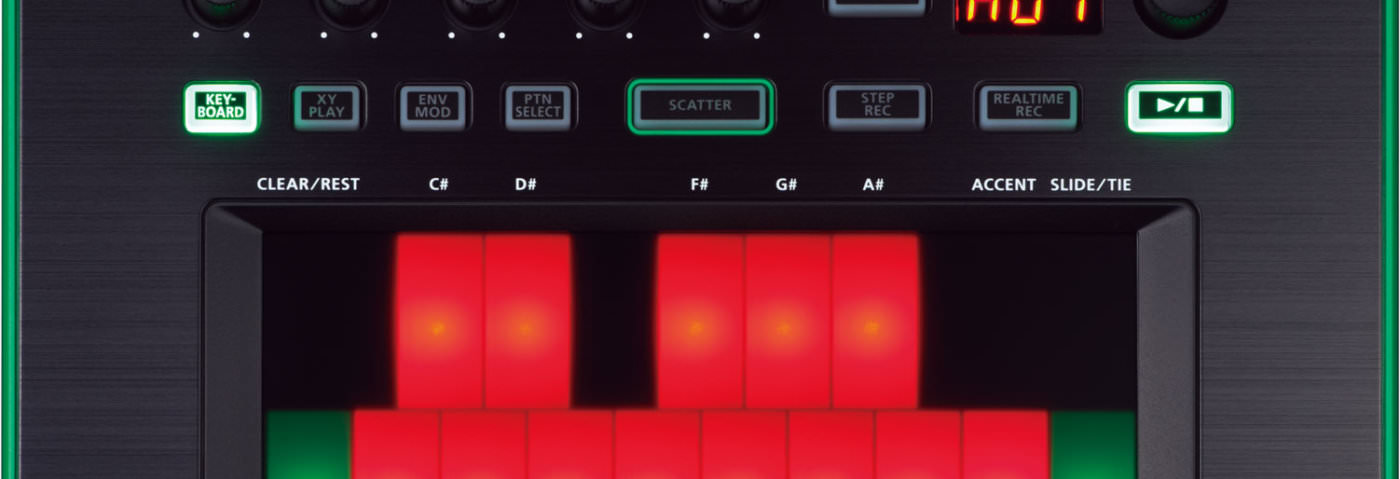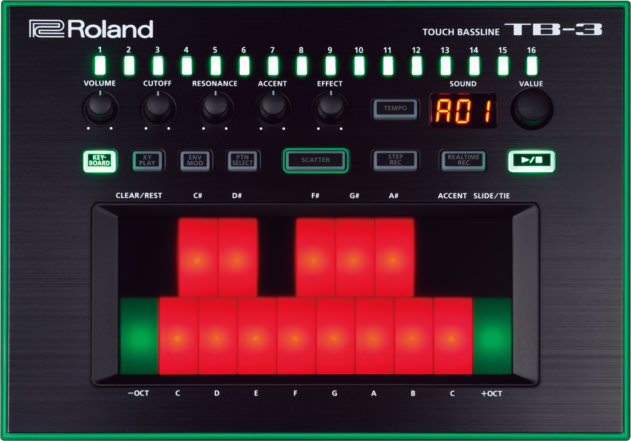Is it ever wise to reinvent a classic? Greg Scarth finds out if Roland’s new take on the 303 concept can update this iconic instrument for the 21st century.
When news broke back in January of the imminent TB-303 and TR-808/909 reboots, a tidal wave of speculation was immediately set in motion. One of the key talking points concerned the direction Roland would take with the ‘new 303’: would it be a like-for-like recreation of the original or something radically different?
The TB-303 is an incredibly basic device: a monophonic synth with just one oscillator, capable of producing a sawtooth or square wave which is fed into a uniquely characterful filter. As such, the sound of the synth is inherently defined by its analogue circuits and components; the 303’s range is incredibly limited, but that means its sound is one of the most recognisable and highly imitated in dance music.
Unlike the 808 and 909, there are also plenty of relatively affordable analogue 303 clones on the market. Even if you can’t stretch to an original model, a x0xb0x or TT-303 will get you very close to the sound of the real thing for a fraction of the price. With the news of the forthcoming Aira range, there was an overwhelming sense that if Roland wanted to recreate the 303 they’d better make sure they got it 100% right.
Like the TR-8, the TB-3 completely avoids the potential trap of trying to produce an exact replica of the 303. Instead, Roland have taken the other route: the TB-3 can
certainly do classic 303 sounds, but that’s only a small part of its feature set. As it turns out, the TB-3 is designed to be a lot more flexible, versatile and user-friendly than a TB-303. Perhaps even more than the TR-8 or VT-3, the TB-3 is without doubt a modern reinterpretation of the original concept rather than a simple clone.
Like the TR-8, the TB-3 completely avoids the potential trap of trying to produce an exact replica of the 303.
Spec
Like the other AIRA units, the TB-3 is entirely digital. All sounds are generated in real time using Roland’s new ACB modelling method. The overall approach also differs slightly from the original. The 303’s control options reflected the simplicity of the synth architecture: alongside the tuning knob and sawtooth/square wave switch on the back panel, the 303 featured just five controls – cutoff frequency, resonance, envelope modulation level, decay and accent – for shaping the synth’s sound. Three of them remain on the TB-3 – the cutoff, resonance and accent controls behave as you’d expect from the original – but the envelope modulation and decay parameters are now controlled directly via the touchscreen.
The revised control panel reflects the extended options of the ACB sound engine, which is obvious as soon as you begin to scroll through the sound banks using the Value rotary encoder. Instead of a simple switch to choose between square waves and sawtooths, the TB-3 offers four banks of patches (a total of 134), organised by type.
Bank A contains original TB-303 sounds, bank B contains bass sounds, bank C contains leads and back D contains FX. Why a whole bank of TB-303 sounds when the 303 only offered square or sawtooth settings? Because each preset also includes an adjustable effect (the depth of which can be adjusted using the Effect knob), while some include variations on the original sound such as built-in distortion. The other banks expand even further on the capabilities of the original, with multi-oscillator sounds and a wide range of effects.
Playing and programming
The Kaoss Pad-style touchpad is the focal point of the entire unit, used for programming sequences, manipulating the filter, adjusting envelope modulation and decay, recalling patterns and controlling the Scatter effect. The touchpad is also pressure-sensitive for modulation control. The screen is a single-touch design, which means it’s incapable of registering the location of two or more fingers simultaneously.
That’s not necessarily a problem for a monophonic synth, but if you’re playing quickly or just accustomed to multi-touch screens on phones and tablets you may find yourself accidentally touching two points on the on-screen keyboard simultaneously, which confuses the TB-3 and plays the note at the mid point of your two fingers. When playing quickly it’s difficult to avoid unwanted notes and impossible to play legato. A multi-touch screen would be too much to ask at this price point, but it can be a little frustrating when trying to jam on the unit in real time.
Despite that minor drawback, the TB-3’s touchscreen-based sequencer is much more intuitive than the TB-303’s notoriously fiddly design. When I interviewed A Guy Called Gerald a couple of years ago
he insisted that programming the 303 is easy. “All you have to do is read the manual, really,” he insisted. Gerald is clearly a better man than me because I’ve read the 303 manual cover to cover a number of times and I still find it annoying. The TB-3, on the other hand, is incredibly easy to program – even without reading the manual. All the basics of the 303’s 16-step sequencer are included – slides, rests and accents – but the sequencer is extended to a maximum loop length of 32 steps.
the TB-3’s touchscreen-based sequencer is much more intuitive than the TB-303’s notoriously fiddly design
Patterns are auto-saved as you go, and can be chained together by swiping a finger across multiple adjacent slots in Pattern Select mode (there’s no conventional Track Write mode like the 303). The sequencer can run from the internal clock (with tap tempo option) or sync to an external MIDI clock signal over DIN or USB. With step or real-time recording, the The lack of metronome is a little frustrating when recording in real time, but otherwise there are very few complaints about the way Roland have designed the TB-3’s sequencer.


04.51 PM
I think it sounds the dog’s proverbial. Really excited to buy one.
12.12 AM
I thought the original TB-303 was an 18db/Oct filter?
08.37 AM
@ Mr Mysterioso – it’s a common misconception, largely because Roland described it as an 18dB/oct filter when it isn’t. Tim Stinchcombe explains it in detail here (summarised below).
http://www.timstinchcombe.co.uk/index.php?pge=diode
—
The 18dB versus 24dB ‘dispute’
[I nearly entitled this section ‘debate’, but that is not really a good word to use here—there simply is no debate: these filters are 4th-order, 4-pole, 24dB/octave attenuation low-pass filters, plain and simple.]
Start reading about the Roland TB-303 and it will not be long before you come across mention of its ’18dB 3-pole lowpass filter’—apparently even Roland themselves described the filter as having these properties.
…
But whatever the reasons, these filters simply are not 18dB 3-pole filters: by all means they could be described as behaving more like 18dB/octave, rather than 24dB/octave, in the main region in which they are used (this could be said of many other filters though, yet isn’t), but they simply cannot escape the fact that they are 4th-order, 4-pole, 24dB/octave filters, and calling them anything else is at best misleading, and at worse, just plain incorrect. If you owned a Porsche 911, but only drove it at 40mph to pick up the shopping on a Saturday afternoon, and somebody asked you what it is, you wouldn’t say “it is a Saturday run-around”, you’d probably say something like “it is a 150mph+ high-performance sports car”, or maybe even “it is a 150mph+ high-performance sports car, but generally I only use it as a Saturday run-around”—just because you don’t use it for what it was normally intended doesn’t stop it being what it is.
08.11 AM
-18 db/oct!!
IGNORANTI